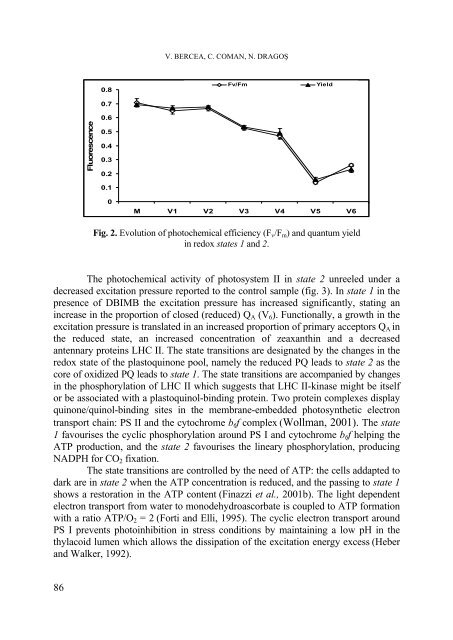biologia - Studia
biologia - Studia
biologia - Studia
Create successful ePaper yourself
Turn your PDF publications into a flip-book with our unique Google optimized e-Paper software.
V. BERCEA, C. COMAN, N. DRAGOŞ<br />
0.8<br />
0.7<br />
Fv/Fm<br />
Yield<br />
Fluorescence<br />
0.6<br />
0.5<br />
0.4<br />
0.3<br />
0.2<br />
0.1<br />
0<br />
M V1 V2 V3 V4 V5 V6<br />
Fig. 2. Evolution of photochemical efficiency (F v /F m ) and quantum yield<br />
in redox states 1 and 2.<br />
The photochemical activity of photosystem II in state 2 unreeled under a<br />
decreased excitation pressure reported to the control sample (fig. 3). In state 1 in the<br />
presence of DBIMB the excitation pressure has increased significantly, stating an<br />
increase in the proportion of closed (reduced) Q A (V 6 ). Functionally, a growth in the<br />
excitation pressure is translated in an increased proportion of primary acceptors Q A in<br />
the reduced state, an increased concentration of zeaxanthin and a decreased<br />
antennary proteins LHC II. The state transitions are designated by the changes in the<br />
redox state of the plastoquinone pool, namely the reduced PQ leads to state 2 as the<br />
core of oxidized PQ leads to state 1. The state transitions are accompanied by changes<br />
in the phosphorylation of LHC II which suggests that LHC II-kinase might be itself<br />
or be associated with a plastoquinol-binding protein. Two protein complexes display<br />
quinone/quinol-binding sites in the membrane-embedded photosynthetic electron<br />
transport chain: PS II and the cytochrome b 6 f complex (Wollman, 2001). The state<br />
1 favourises the cyclic phosphorylation around PS I and cytochrome b 6 f helping the<br />
ATP production, and the state 2 favourises the lineary phosphorylation, producing<br />
NADPH for CO 2 fixation.<br />
The state transitions are controlled by the need of ATP: the cells addapted to<br />
dark are in state 2 when the ATP concentration is reduced, and the passing to state 1<br />
shows a restoration in the ATP content (Finazzi et al., 2001b). The light dependent<br />
electron transport from water to monodehydroascorbate is coupled to ATP formation<br />
with a ratio ATP/O 2 = 2 (Forti and Elli, 1995). The cyclic electron transport around<br />
PS I prevents photoinhibition in stress conditions by maintaining a low pH in the<br />
thylacoid lumen which allows the dissipation of the excitation energy excess (Heber<br />
and Walker, 1992).<br />
86
















